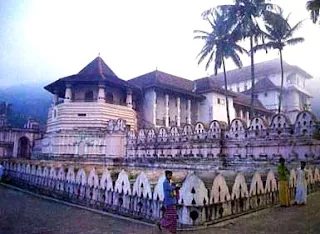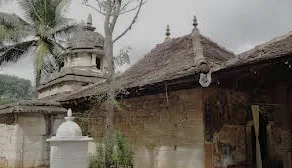The Sacred City of Kandy was inscribed by UNESCO as Sri Lanka's fifth and the world's 450th World Heritage site. The reason is its religious and historical significance as an internationally renowned Buddhist pilgrimage site and as Sri Lanka's last royal capital.
The Kandy Kingdom in the hillcountry, independent till 1815, managed to preserve Sri Lanka's Sinhalese culture when the lowlands came under Portuguese and later on Dutch influence. Particularly the Portuguese, on behalf of Roman Catholic spiritual leadership, suppressed Sinhala Buddhist and Tamil Hindu and Moor Muslim culture, for instance by destroying their sacred sites in the lowland territories under their control.
Originally called Senkadagalapura, the new Sinhalese royal capital in the highlands became known as Nuwara or Mahanuwara, which is the Sinhala word for "town" or "grand town" respectively. The Sinhala term "kanda", from which the British derived the name "Kandy", in its original local sense, referred not the city but the hillcountry. In a way, Kandy and hillcountry are synonymous. Until 1815, the Kandyan Kingdom in the highlands had remained independent from colonial rule, longer than any other part of the island.
Places to visit when visiting Kandy Dalada Palace
It’s not the entire town known as Sri Lanka's cozy hill capital that is a World Heritage Site. Rather, it is the sacral and royal area of Kandy which was inscribed by UNESCO in 1988, the eastern quarter of the inner city, surrounding the gardens at the Kandy Lake in particular. The Sacred City of Kandy listed as World Heritage Site No. 450 consists of Buddhist temples and monasteries as well as adjoining shrines where Sinhalese Buddhists venerate Hindu deities, plus the lake and the hill framing this area.
- Rocal palace Complex housing the Archaeological museum
- Hatara Devales shrines of Natha, Vishnu, Pattini, and Kataragama
- Malwatta Rajamaha Viharaya, Buddhist monastery
- Asgiriya Rajamaha Viharaya, Buddhist monastery
- Udawattakale forest sanctury
- Raja Museum
The area of the World Heritage Site called "Sacred City of Kandy" forms a crescent are semi-circle around Kandy downtown: from Asgiriya in the northwest, Udawatte forest in the northeast, Touth Temple with adjacent palace and three Hindu shrines in the east as the core of the sacred area and the lake and Malwatta Viharaya to the southeast of the city centre. An exception from this "crescent pattern" of the Sacred City of Kandy is the fourth Hindu shrine, the Kataragama Devale, which is situated right in the centre of the profane and inhabited commercial inner city which is otherwise not a UNESCO World Heritage site.
TEMPLE OF THE SACRED TOOTH RELIC
The Temple of the Sacred Tooth Relic is the most important Buddhist pilgrimage site in Sri Lanka. It is of high significance for the Sinhalese culture and the state of Sri Lanka. Till the present day, newly elected presidents of Sri Lanka visit the Tooth Temple immediately after their inauguration ceremony in Colombo. Representants of the state also take part in religious ceremonies at this edifice, for instance when new high priests of the two Kandyan orders Malwatta and Asgiriya are installed, both of whom share the power of the keys to the Tooth Relic. The Tooth temple in Kandy has been intimately connected to political power since the 16th century, particularly during the era of Kandy Kings. Actually, the Tooth Temple formed a part of the king's palace compound. In contrast to most other Buddhist sanctuaries in Sri Lanka, the Temple of the Tooth Relic has not been a part of a Buddhist monastery. Within the precincts of the royal palace, the Sacred Tooth was considered to be the palladium of the kingdom. As such, it was under the shared control of religious and secular dignitaries as well as under divine protection, the king serving as its safekeeper and the deities of the adjacent shrines being its heavenly guardians.
Not much remained of the Royal Palace, which was damaged during wars with the British. The only surviving wing of the former palace now houses the Archaeological Museum of Kandy, not to be confused with the National Museum and International Buddhist Museum, which are both behind the Tooth Relic Temple.
Even during the colonial wars, the Tooth Temple remained untouched. Most of the temple edifices are from the late Kandy period, erected about 1800 or even later. Only the core building, a wooden hall sheltering the Tooth Relic and crowned by a gilded roof, is from the 17th century. This two-storeyed central edifice of the Tooth Temple complex is the most significant example of Kandyan wood architecture.
The octogon of the Tooth Temple's front wall and the lake, both landmarks of Kandy, are later additions, they were constructed during the reign of the last Kandy King, Sro Vikrama Rajasin from
Four Great Temples
In the same sacred area of palace and tooth temple, which forms the elevated eastern extension of the inner city, are three more temples. They belong to the so-called Hatara Devales, the four shrines of Kandy's guardian deities. As mentioned, the fourth one, dedicated to Kataragama, is situated separately and a little bit hidden in the central business and market area of Kandy. The three Hindu shrines are located at the Madduna Bandara Uyana Park in front of the Royal Palace and Tooth Temple terrace, on a slightly lower level.
Devales are Sinhalese shrines for Hindu deities, whereas Tamil Hindu shrines are called Kovils. Sinhalese Buddhists also worship specific Hindu and local gods, which are regarded as guardians of both the island and its Buddhist religion. The Hatare Devales alias Four Sanctuaries are dedicated to the pantheon of four highest Hindu gods of Sinhalese Buddhists. The number of four principal deities is very ancient, but the specific gods counted as these varied during the course of the centuries. During the Kandyan period, the regional gods of the west and of Adam's Peak, namely Vibhishana resp. Saman were replaced by the protector of the Kandy valley, Natha, and by a Tamil goddess of southern Indian origin, Pattini. Upulvan, the prominent god of the Anuradhapura period, was identified with Vishnu during the Kandyan period. Only the name of Kataragama remained unchanged.
Vishnu Devale

Vishnu is the highest of those four gods of the Kandy Kingdom, or more precisely: Vishnu it a kind of primus inter pares. His Devale is the highest one uphill. The opening ceremony of the annual Kandy Festival known as Esala Perahera is held at this temple. The best examples of moonstones in the Kandyan style, which is triangular in contrast to the semi-circulat shape of Anuradhapura and Polonnaruw moonstones, can be seen in this temple complex.
Natha Devale
Natha was a local god of the Kandy valley, later on venerated ass a Bodhisattva, too. His shrine is the oldest surviving temple structure in the Kandyan valley. There are older sanctuaries around Kandy, viz. the cave temple at Hindagala. But the Natha Devale is the only actual building from the pre-Kandyan period in Kandy. It was ferected Gampola's King Vikramabahu III in the 14th century. During the Kandy period, the coronation of kings was held at this temple by handing over the royal sword to him. The symbolism is: The worldly protector of Kandy is protected by the divine protector, Natha.
Pattini Devale
Pattini is the Sinhalese version of Kannagi (Kannaki), a later on deified legendary female hero who is the main character of the classic Tamil epic, the Silapathikaram. She is said to have arrived on the island already during the Anuradhapura period. But her cult was not known prior to the Kandy period. Her small Devale, which is situated close to the huge Bo-Tree and the Anglican church of St Paul, is frequented by local women who pray for offspring.
Kataragama Devale
Kataragama is the Sri Lankan form of the Tamil god Murugan and pan-Indian Bahmanic deity known as Skanda or Subhramanya or Kumara. His temple in the market area of Kandy is an oasis of peace in the hustle and bustle. A shrine with a Buddha statue and several shrines of Hindu deities are also found in the premises of the Kataragama Devale.
Remarkably, two of the four deities venerated by Sinhalese Buddhists are closely connected to Tamil mythology.
The priests at the four temples are usually Sinhalese Kapuralas, not belonging to a priestly cast. Only the Kataragama shrine, though a Sinhalese Devale, is lead by Tamil Brahmins. The four Hindu Devales play a major role in the annual Kandy Perahera, the procession of the Holy Tooth relic in Kandy.
Two major Siamese monasteries of the Upland Buddhist order
There are two Buddhist monasteries in Kandy belonging to the World Heritage Site, the Sacred City of Kandy. They are the head offices of the two branches of the so-called Syam Nikaya. Nikaya means “a Buddhist order”. Syam means “Siam”, the kingdom that is now called Thailand. In the 18th century the Sinhalese monk Saranankara, supported by King Kirti Sri Rajasinghe, reformed the Buddhist order by introducing the Siamese line of ordination with the help of the Thai monk Upali. By the way, there were two more reform movements later on introducing ordination lines from Myanmar (Birma). Hence, there are three main orders in Sinhalese Buddhism today. The Syam Nikaya, the oldest of them, is predominant in the hill country, though some important lowland moansteries such as Dambulla in the Cultural Triangle and Mulkirigala in the Southern Province belong to the Syam Nikaya, too.
Malwatta Rajamaha Viharaya
Most monasteries of this "Siamese Order" belong to the Malwatta chapter, which is the much larger branch, comprising 80 or 90 % of the monks or monasteries of the Syam Nikaya. The main monastery of this chapter, Malwatta Rajamaha Viharaya, is situated at the southern banks of the Kandy Lake. The entrance gate is flanked by an octogon similar to that of the Sacred Tooth Temple. Without intending to insult other orders, Malwatta can be called Sri Lanka’s most important monastery. The main building in the temple courtyard is an ordination hall, recognizable as such by eight Bai Sema stones surrounding it at the corners and the cardinal points. A little bit hidden in the dwelling area of the monks, there is a small but very interesting museum documenting the history of the Syam Nikayaas well as Kandy history and the traditional way of life of monks.
Asgiriya Rajamaha Viharaya
The Asgiriya branch is a little bit more reclusive, in a way, it resembles the brotherhoods of forest monasteries which in historical times formed a branch of the city monateries of Anuradhapura. The Asgiriya monastery (Asgiriya Mahavihara) is located in the north-eastern outskirts of Kandy town. It was founded already in the early 14th century by King Parakramabahu IV, who built a tooth temple in Kurunegala. The buildings of the Asgiriya temple are modern. One image hall has a large recling Buddha.
Raja Museum
On August 20, 1986 President J. R. Jayewardene declared Raja as a national treasure in recognition of his invaluable services to the Buddhist religion. Raja, the great tusker, which carried the Sacred Relic Casket for more than half a century, is honored by the Dalada Maligawa by preserving the dead animal's skin and tusks prepared to look like the tusker when alive. The museum which is located in a small building adjacent to the Royal Palace is visited by tourists and pilgrims who throng themselves to the Sri Dalada Maligawa.













0 Comments